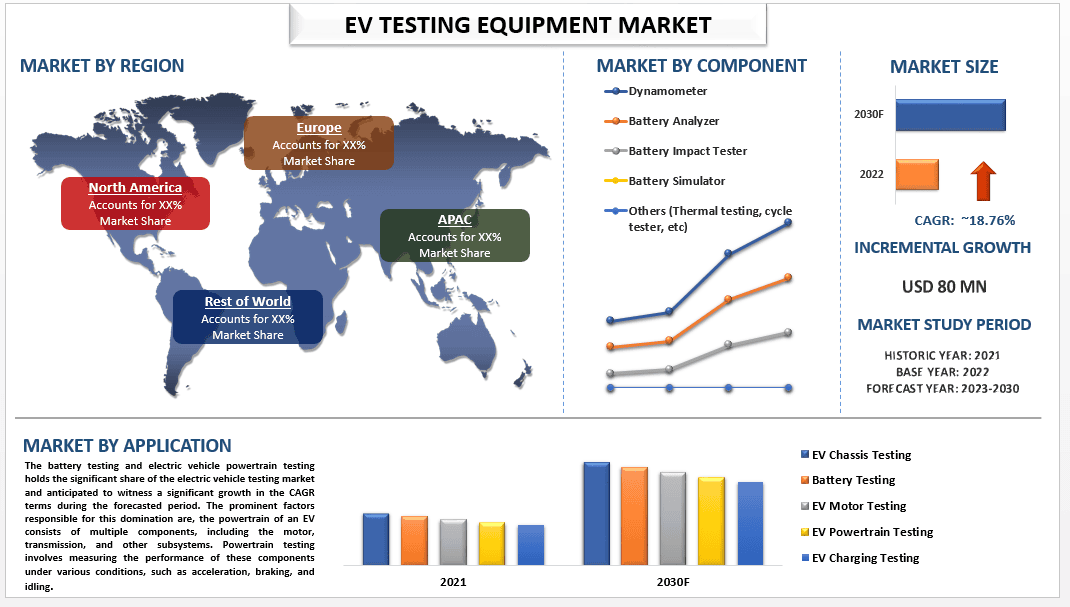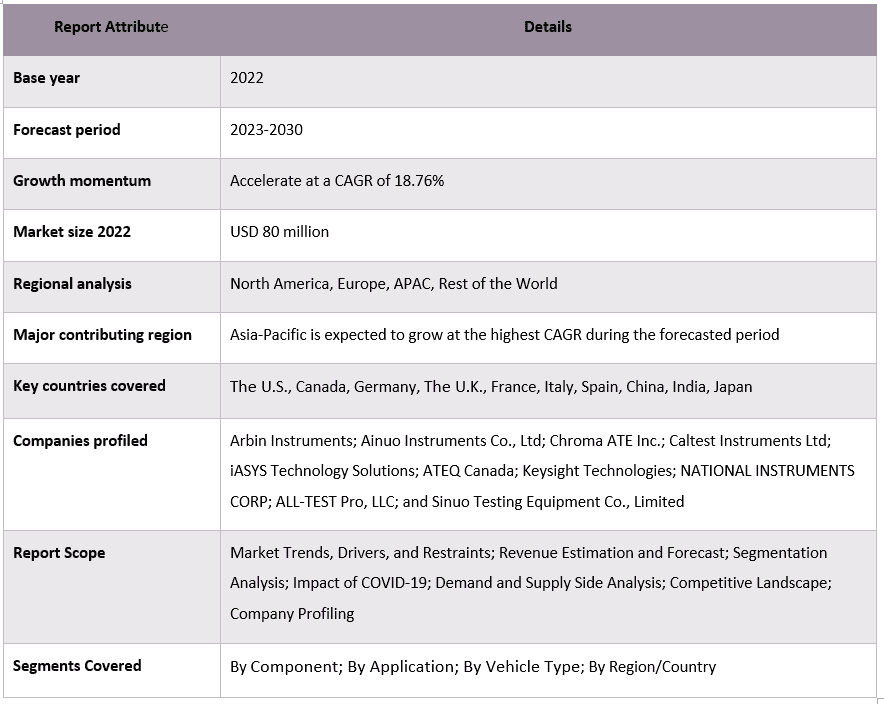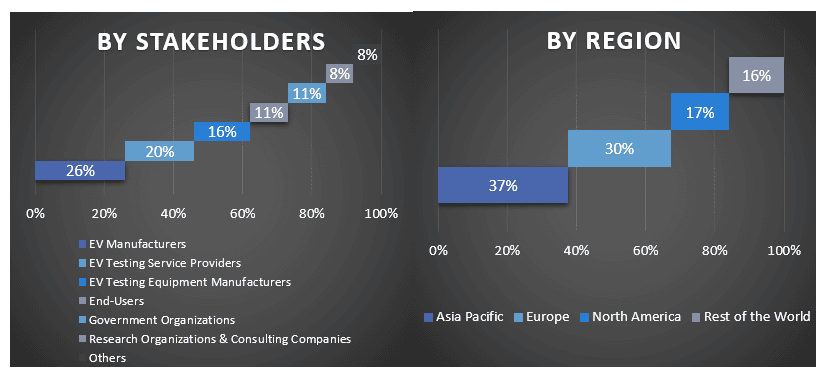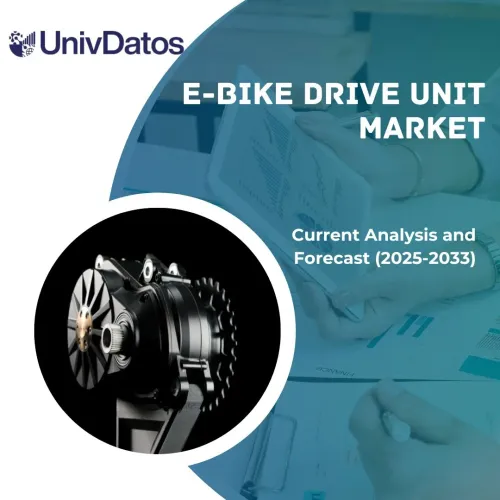- Trang chủ
- Về chúng tôi
- Ngành
- Dịch vụ
- Đọc
- Liên hệ với chúng tôi
Thị trường Thiết bị Kiểm tra EV: Phân tích Hiện tại và Dự báo (2023-2030)
Chú trọng vào Thành phần (Máy đo lực, Máy phân tích pin, Máy kiểm tra tác động pin, Thiết bị kiểm tra điện tử công suất, Bộ mô phỏng pin, Khác (Kiểm tra nhiệt, máy kiểm tra chu kỳ, v.v.); Ứng dụng (Kiểm tra khung gầm xe điện, Kiểm tra pin, Kiểm tra động cơ xe điện, Kiểm tra hệ thống truyền động xe điện, Kiểm tra sạc xe điện); Loại xe (Xe chở khách, Xe thương mại và Xe hai bánh); và Khu vực/Quốc gia

Thị trường Thiết bị Kiểm tra Xe điện được định giá 80 triệu đô la vào năm 2022 và dự kiến sẽ tăng trưởng với tốc độ ổn định khoảng 18,76% trong giai đoạn dự báo (2023-2030), do việc áp dụng xe điện ngày càng tăng và các chính sách an toàn nghiêm ngặt đối với sự phát triển của xe điện. Xe điện (EV) đã trở nên phổ biến trong những năm gần đây do tiềm năng giảm phát thải khí nhà kính và cải thiện chất lượng không khí. Để đảm bảo an toàn và hiệu suất của những chiếc xe này, thiết bị kiểm tra xe điện là rất cần thiết. Thiết bị kiểm tra xe điện đề cập đến các thiết bị được sử dụng để đánh giá hiệu suất, chức năng và độ an toàn của xe điện. Các thử nghiệm này bao gồm nhiều khía cạnh khác nhau, bao gồm hệ thống quản lý pin (BMS), bộ điều khiển động cơ (MCU), các thành phần hệ thống truyền động, hệ thống phanh, hệ thống treo và hệ thống lái. Thiết bị này bao gồm máy đo lực, máy đo gia tốc, máy kiểm tra điện áp, máy kiểm tra dòng điện, cảm biến nhiệt độ và các công cụ chuyên dụng khác được thiết kế đặc biệt cho việc kiểm tra xe điện. Hơn nữa, đảm bảo an toàn cho xe điện là rất quan trọng và điều này đòi hỏi phải kiểm tra nghiêm ngặt. Các nhà sản xuất phải tuân thủ các quy định an toàn nghiêm ngặt, đòi hỏi phải sử dụng thiết bị kiểm tra chuyên dụng để phát hiện các mối nguy hiểm và lỗi tiềm ẩn. Một số nhà sản xuất đã thành lập các cơ sở thử nghiệm chuyên dụng để tiến hành thử nghiệm rộng rãi xe điện. Các cơ sở này thường có các phòng thí nghiệm tiên tiến, các ô thử nghiệm động và các thiết bị chuyên dụng để đánh giá các hệ thống con khác nhau của xe điện, điều này đang thúc đẩy nhu cầu về thiết bị kiểm tra xe điện. Hơn nữa, sự phát triển của các công nghệ pin thế hệ tiếp theo, chẳng hạn như pin trạng thái rắn và pin lithium-air, hứa hẹn sẽ cách mạng hóa lĩnh vực xe điện. Những tiến bộ này sẽ đòi hỏi thiết bị kiểm tra chuyên dụng để đánh giá hiệu suất và độ an toàn của chúng trong các điều kiện khác nhau. Ví dụ: vào tháng 6 năm 2023, tại một cuộc họp giao ban công nghệ, Toyota, một trong những nhà sản xuất ô tô lớn nhất thế giới, đã công bố một bước đột phá trong công nghệ pin trạng thái rắn mà họ đang phát triển và tuyên bố rằng bước đột phá công nghệ này có thể tăng thêm tới 900 dặm phạm vi lái xe cho xe điện. Ngoài ra, việc tích hợp ngày càng nhiều hệ thống lái tự động vào xe điện đi kèm với những thách thức thử nghiệm mới. Nơi các nhà sản xuất cần phát triển và triển khai các giao thức thử nghiệm mạnh mẽ để đảm bảo an toàn và độ tin cậy của ADAS, tiếp tục làm tăng nhu cầu về thiết bị kiểm tra xe điện.
Một số nhà sản xuất lớn hoạt động trên thị trường bao gồm Arbin Instruments; Ainuo Instruments Co., Ltd; Chroma ATE Inc.; Caltest Instruments Ltd; iASYS Technology Solutions; ATEQ Canada; Keysight Technologies; NATIONAL INSTRUMENTS CORP; ALL-TEST Pro, LLC; và Sinuo Testing Equipment Co., Limited. Một số hoạt động M&A cùng với quan hệ đối tác đã được thực hiện bởi những người chơi này để tạo điều kiện cho khách hàng các sản phẩm/công nghệ công nghệ cao và sáng tạo.
Thông tin chi tiết được trình bày trong Báo cáo
“Trong số các thành phần, máy phân tích pin dự kiến sẽ tăng trưởng với tốc độ CAGR đáng kể trong giai đoạn dự báo.”
Dựa trên thành phần, thị trường được phân đoạn thành máy đo lực, máy phân tích pin, máy kiểm tra tác động pin, thiết bị kiểm tra điện tử công suất, bộ mô phỏng pin và các loại khác (kiểm tra nhiệt, máy kiểm tra chu kỳ, v.v.). Các thành phần được đề cập ở trên đều là thiết bị kiểm tra thiết yếu, cho quy trình chế tạo một chiếc xe điện an toàn và đáng tin cậy hơn cho người tiêu dùng. Nhưng trong số đó, máy phân tích pin là một trong những thiết bị kiểm tra quan trọng nhất, vì pin là trái tim của một chiếc xe điện và điều quan trọng là phải đảm bảo chức năng thích hợp và an toàn của pin. Máy phân tích pin cung cấp thông tin chi tiết về trạng thái sạc, điện áp, nhiệt độ và tình trạng của pin, giúp các kỹ sư tối ưu hóa hiệu suất và tuổi thọ của nó. Hơn nữa, nó cũng cho phép theo dõi chính xác dung lượng, mật độ năng lượng và tốc độ tự xả của pin, đây là những thông số quan trọng để xác định phạm vi và hiệu quả tổng thể của xe điện. Hơn nữa, thiết bị kiểm tra điện tử công suất cũng là một công cụ thiết yếu để kiểm tra xe điện và cung cấp các ưu điểm như đo lường chính xác hiệu suất của thiết bị điện tử công suất, chẳng hạn như hiệu quả, hệ số công suất và độ méo. Hơn nữa, góp phần vào sự phát triển của các thiết bị điện tử công suất hiệu quả và nhỏ gọn hơn, có thể dẫn đến tiết kiệm trọng lượng và cải thiện hiệu quả nhiên liệu.
“Trong số các loại xe, phân khúc xe điện chở khách chiếm thị phần đáng kể trên thị trường vào năm 2022.”
Dựa trên loại xe, thị trường được phân đoạn thành xe chở khách, xe thương mại và xe hai bánh. Phân khúc xe chở khách chiếm thị phần đáng kể trên thị trường. Sự phổ biến ngày càng tăng của xe điện chở khách (PEV) là do tính hiệu quả về chi phí và tổng chi phí sở hữu thấp của PEV. Hơn nữa, với công nghệ pin ngày càng được cải thiện, pin đang trở nên rẻ hơn, an toàn hơn, nhẹ hơn và đáng tin cậy hơn, giúp tăng cường khả năng chấp nhận và thúc đẩy tâm lý người tiêu dùng về xe điện. Ngoài ra, sự sẵn có ngày càng tăng của xe điện với việc ra mắt ngày càng tăng của các nhà sản xuất đã khiến chúng trở nên dễ thấy hơn trong ý thức cộng đồng, góp phần hơn nữa vào sự phổ biến ngày càng tăng của chúng và bổ sung vào nhu cầu PEV vốn đã được thổi phồng.
Phạm vi Báo cáo Thị trường Thiết bị Kiểm tra Xe điện

“Châu Á-Thái Bình Dương sẽ dẫn đầu sự tăng trưởng trong phân khúc thiết bị kiểm tra xe điện trong giai đoạn dự báo (2022-2030).”
Châu Á-Thái Bình Dương chiếm một thị phần đáng kể trong thị trường thiết bị kiểm tra xe điện vào năm 2022. Khu vực này đã chứng kiến sự gia tăng đáng kể trong việc sử dụng xe điện (EV) do nhận thức ngày càng tăng về tính bền vững của môi trường và việc thực hiện các quy định về khí thải nghiêm ngặt. Các quốc gia như Trung Quốc, Nhật Bản, Hàn Quốc và Ấn Độ đã có những bước tiến vượt bậc để thúc đẩy việc sử dụng xe điện, dẫn đến yêu cầu ngày càng cao đối với các giải pháp thử nghiệm hiệu quả và tiện lợi. Hơn nữa, có một sự gia tăng đáng kể trong các khoản đầu tư và tài trợ được phân bổ cho việc phát triển và thương mại hóa xe điện trong khu vực. Các chính phủ và các tổ chức tư nhân đã xác định tiềm năng của xe điện và các khoản đầu tư liên quan đến cơ sở hạ tầng của chúng để tạo điều kiện cho việc sử dụng rộng rãi xe điện, dẫn đến một dòng tài nguyên đáng kể để tiếp thêm sinh lực cho sự tăng trưởng của chúng. Để chứng minh, vào tháng 3 năm 2020, chính phủ Nhật Bản đã công bố kế hoạch lắp đặt 20.000 trạm sạc nhanh trên khắp đất nước với ngân sách 40 tỷ JPY (khoảng 360 triệu USD) vào năm 2025. Loại sáng kiến này không chỉ tăng cường nhu cầu về xe điện mà còn làm tăng nhu cầu về thiết bị kiểm tra xe điện.
Lý do nên mua báo cáo này:
- Nghiên cứu bao gồm phân tích quy mô thị trường và dự báo được xác thực bởi các chuyên gia hàng đầu trong ngành đã được xác thực.
- Báo cáo trình bày một đánh giá nhanh về hiệu quả hoạt động chung của ngành trong nháy mắt.
- Báo cáo bao gồm phân tích chuyên sâu về các đồng nghiệp nổi bật trong ngành với trọng tâm chính là tài chính kinh doanh quan trọng, danh mục sản phẩm, chiến lược mở rộng và các phát triển gần đây.
- Kiểm tra chi tiết các động lực, hạn chế, xu hướng chính và cơ hội hiện hành trong ngành.
- Nghiên cứu bao gồm toàn diện thị trường trên các phân khúc khác nhau.
- Phân tích sâu cấp khu vực của ngành.
Tùy chọn Tùy chỉnh:
Thị trường thiết bị kiểm tra xe điện toàn cầu có thể được tùy chỉnh thêm theo yêu cầu hoặc bất kỳ phân khúc thị trường nào khác. Bên cạnh đó, UMI hiểu rằng bạn có thể có nhu cầu kinh doanh riêng, vì vậy hãy thoải mái liên hệ với chúng tôi để có được một báo cáo hoàn toàn phù hợp với yêu cầu của bạn.
Mục lục
Phương Pháp Nghiên Cứu Phân Tích Thị Trường Thiết Bị Kiểm Tra EV (2023-2030)
Phân tích thị trường lịch sử, ước tính thị trường hiện tại và dự báo thị trường tương lai của thị trường thiết bị kiểm tra EV toàn cầu là ba bước chính được thực hiện để tạo và phân tích việc áp dụng thiết bị kiểm tra EV ở các khu vực chính trên toàn cầu. Nghiên cứu thứ cấp toàn diện đã được tiến hành để thu thập số liệu thị trường lịch sử và ước tính quy mô thị trường hiện tại. Thứ hai, để xác thực những thông tin chi tiết này, nhiều phát hiện và giả định đã được xem xét. Hơn nữa, các cuộc phỏng vấn sơ cấp toàn diện cũng đã được thực hiện với các chuyên gia trong ngành trên toàn bộ chuỗi giá trị của thị trường thiết bị kiểm tra EV toàn cầu. Sau khi giả định và xác thực số liệu thị trường thông qua các cuộc phỏng vấn sơ cấp, chúng tôi đã sử dụng phương pháp tiếp cận từ trên xuống/từ dưới lên để dự báo quy mô thị trường hoàn chỉnh. Sau đó, các phương pháp phân tích chi tiết thị trường và phân tích tam giác dữ liệu đã được áp dụng để ước tính và phân tích quy mô thị trường của các phân khúc và phân khúc phụ liên quan đến ngành. Phương pháp chi tiết được giải thích dưới đây:
Phân Tích Quy Mô Thị Trường Lịch Sử
Bước 1: Nghiên Cứu Chuyên Sâu Các Nguồn Thứ Cấp:
Nghiên cứu thứ cấp chi tiết đã được thực hiện để có được quy mô thị trường lịch sử của thị trường thiết bị kiểm tra EV thông qua các nguồn nội bộ của công ty như báo cáo thường niên & báo cáo tài chính, các bài thuyết trình về hiệu suất, thông cáo báo chí, v.v., và các nguồn bên ngoài bao gồm tạp chí, tin tức & bài viết, ấn phẩm của chính phủ, ấn phẩm của đối thủ cạnh tranh, báo cáo ngành, cơ sở dữ liệu của bên thứ ba và các ấn phẩm đáng tin cậy khác.
Bước 2: Phân Khúc Thị Trường:
Sau khi có được quy mô thị trường lịch sử của thị trường thiết bị kiểm tra EV, chúng tôi đã tiến hành phân tích thứ cấp chi tiết để thu thập thông tin chi tiết về thị trường lịch sử và chia sẻ cho các phân khúc & phân khúc phụ khác nhau cho các khu vực chính. Các phân khúc chính được bao gồm trong báo cáo là điện áp, ứng dụng và người dùng cuối. Phân tích cấp quốc gia sâu hơn đã được tiến hành để đánh giá việc áp dụng tổng thể các mô hình thử nghiệm trong khu vực đó.
Bước 3: Phân Tích Yếu Tố:
Sau khi có được quy mô thị trường lịch sử của các phân khúc và phân khúc phụ khác nhau, chúng tôi đã tiến hành phân tích yếu tố chi tiết để ước tính quy mô thị trường hiện tại của thị trường Thiết bị Kiểm tra EV. Hơn nữa, chúng tôi đã tiến hành phân tích yếu tố bằng cách sử dụng các biến phụ thuộc và độc lập như thành phần, ứng dụng và loại xe của thị trường thiết bị kiểm tra EV. Một phân tích kỹ lưỡng đã được tiến hành cho các kịch bản phía cung và phía cầu, xem xét các quan hệ đối tác hàng đầu, sáp nhập và mua lại, mở rộng kinh doanh và ra mắt sản phẩm trong lĩnh vực thị trường thiết bị kiểm tra EV trên toàn cầu.
Ước Tính & Dự Báo Quy Mô Thị Trường Hiện Tại
Định cỡ Thị trường Hiện tại: Dựa trên những hiểu biết sâu sắc có thể hành động từ 3 bước trên, chúng tôi đã xác định được quy mô thị trường hiện tại, những người chơi chính trong thị trường Thiết bị Kiểm tra EV toàn cầu và thị phần của các phân khúc. Tất cả tỷ lệ phần trăm chia sẻ, và phân tích chi tiết thị trường cần thiết đã được xác định bằng cách sử dụng phương pháp thứ cấp đã đề cập ở trên và được xác minh thông qua các cuộc phỏng vấn sơ cấp.
Ước tính & Dự báo: Để ước tính và dự báo thị trường, trọng số đã được gán cho các yếu tố khác nhau bao gồm các động lực & xu hướng, hạn chế và cơ hội có sẵn cho các bên liên quan. Sau khi phân tích các yếu tố này, các kỹ thuật dự báo có liên quan, tức là phương pháp tiếp cận từ trên xuống/từ dưới lên, đã được áp dụng để đưa ra dự báo thị trường cho năm 2030 cho các phân khúc và phân khúc phụ khác nhau trên các thị trường lớn trên toàn cầu. Phương pháp nghiên cứu được áp dụng để ước tính quy mô thị trường bao gồm:
- Quy mô thị trường của ngành, về doanh thu (USD) và tỷ lệ chấp nhận của thị trường thiết bị kiểm tra EV trên các thị trường lớn trong nước
- Tất cả tỷ lệ phần trăm chia sẻ, chia nhỏ và phân tích chi tiết của các phân khúc và phân khúc phụ của thị trường
- Những người chơi chính trong thị trường thiết bị kiểm tra EV toàn cầu về các sản phẩm được cung cấp. Ngoài ra, các chiến lược tăng trưởng được những người chơi này áp dụng để cạnh tranh trong thị trường đang phát triển nhanh chóng.
Xác thực Quy Mô và Thị Phần Thị Trường
Nghiên Cứu Sơ Cấp: Các cuộc phỏng vấn chuyên sâu đã được thực hiện với các Nhà Lãnh Đạo Quan Điểm Chính (KOL) bao gồm các Giám Đốc Điều Hành Cấp Cao (CXO/VP, Trưởng Phòng Kinh Doanh, Trưởng Phòng Marketing, Trưởng Phòng Điều Hành, Trưởng Khu Vực, Trưởng Chi Nhánh, v.v.) trên khắp các khu vực chính. Các phát hiện nghiên cứu sơ cấp sau đó được tóm tắt và phân tích thống kê đã được thực hiện để chứng minh giả thuyết đã nêu. Các thông tin đầu vào từ nghiên cứu sơ cấp đã được hợp nhất với các phát hiện thứ cấp, do đó biến thông tin thành những hiểu biết sâu sắc có thể hành động.
Phân Chia Người Tham Gia Sơ Cấp ở Các Khu Vực Khác Nhau

Kỹ Thuật Thị Trường
Kỹ thuật phân tích tam giác dữ liệu đã được sử dụng để hoàn thành việc ước tính thị trường tổng thể và để đưa ra các số liệu thống kê chính xác cho từng phân khúc và phân khúc phụ của thị trường thiết bị kiểm tra EV toàn cầu. Dữ liệu đã được chia thành nhiều phân khúc & phân khúc phụ sau khi nghiên cứu các thông số và xu hướng khác nhau trong các lĩnh vực điện áp, ứng dụng và người dùng cuối trong thị trường thiết bị kiểm tra EV toàn cầu.
Mục Tiêu Chính của Nghiên Cứu Thị Trường Thiết Bị Kiểm Tra EV Toàn Cầu
Các xu hướng thị trường hiện tại & tương lai của thị trường thiết bị kiểm tra EV toàn cầu đã được xác định trong nghiên cứu. Các nhà đầu tư có thể có được những hiểu biết chiến lược để dựa trên sự thận trọng của họ cho các khoản đầu tư dựa trên phân tích định tính và định lượng được thực hiện trong nghiên cứu. Các xu hướng thị trường hiện tại và tương lai xác định sức hấp dẫn tổng thể của thị trường ở cấp khu vực, cung cấp một nền tảng cho người tham gia công nghiệp khai thác thị trường chưa được khai thác để hưởng lợi từ lợi thế của người đi đầu. Các mục tiêu định lượng khác của các nghiên cứu bao gồm:
- Phân tích quy mô thị trường hiện tại và dự báo của thị trường thiết bị kiểm tra EV về giá trị (USD). Ngoài ra, phân tích quy mô thị trường hiện tại và dự báo của các phân khúc và phân khúc phụ khác nhau.
- Các phân khúc trong nghiên cứu bao gồm các lĩnh vực thành phần, ứng dụng và loại xe.
- Xác định và phân tích khuôn khổ pháp lý cho thiết bị kiểm tra EV
- Phân tích chuỗi giá trị liên quan đến sự hiện diện của nhiều trung gian khác nhau, cùng với việc phân tích hành vi của khách hàng và đối thủ cạnh tranh của ngành
- Phân tích quy mô thị trường hiện tại và dự báo của thị trường thiết bị kiểm tra EV cho khu vực chính
- Các quốc gia lớn của các khu vực được nghiên cứu trong báo cáo bao gồm Châu Á Thái Bình Dương, Châu Âu, Bắc Mỹ và Phần Còn Lại của Thế Giới
- Hồ sơ công ty của thị trường thiết bị kiểm tra EV và các chiến lược tăng trưởng được những người chơi trên thị trường áp dụng để duy trì trong thị trường đang phát triển nhanh chóng
- Phân tích sâu sắc cấp khu vực của ngành
Liên quan Báo cáo
Khách hàng đã mua mặt hàng này cũng đã mua










